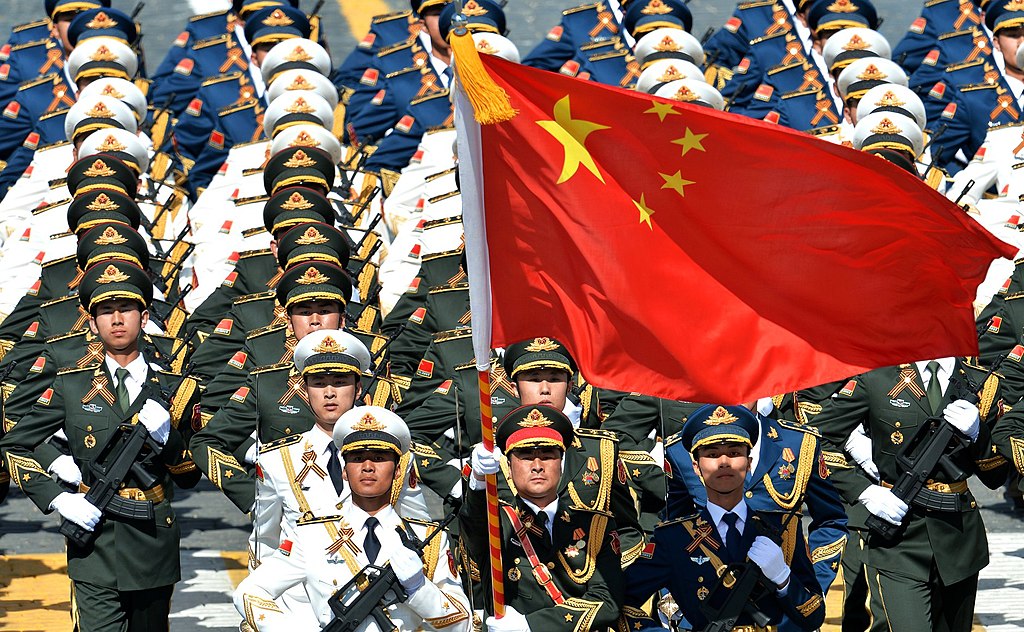What the Defense Department’s 2021 China Military Power Report Tells Us About Defense Innovation
According to the China Military Power Report, China is transitioning to a new stage in its national strategy in which emerging technologies and defense innovation are playing a central role in more recent iterations of the CCP’s strategic objectives.

Published by The Lawfare Institute
in Cooperation With

The Chinese Communist Party (CCP) is increasingly public about its national efforts—and its timelines—to achieve a “great rejuvenation” of China through technology leadership. The CCP hopes by 2049 to accomplish its centenary goal of maturing into “a modern socialist country that is prosperous, strong, democratic, culturally advanced and harmonious”; by 2035 to complete its “China Standards” push to standardize and create interoperability in emerging technologies; by 2030 to become the world leader in artificial intelligence (AI); by 2027 to reach its recently announced aim to completely modernize the People’s Liberation Army (PLA) into a force capable of “intelligentized” warfare; and by 2025 to fulfill its “Made in China” objectives of growing the amount of high-tech goods manufactured in China from agricultural technologies to maritime and aerospace engineering. These wide-ranging goals are contingent, if not focused explicitly, on China strengthening its command of emerging technologies, as the U.S. Department of Defense’s 2021 annual China Military Power Report to Congress makes clear. These emerging technologies include AI and advanced robotics, semiconductors and advanced computing, quantum, biotechnology, hypersonic and directed energy weapons, and advanced materials and alternative energy.
The Defense Department report elaborates on earlier sentiments expressed by the Biden administration’s Interim National Security Strategic Guidance that China is the only competitor to the United States “capable of combining its economic, diplomatic, military, and technological power to mount a sustained challenge to a stable and open international system.” According to the China Military Power Report, which covers the CCP’s military and security developments in 2020, China is transitioning to a new stage in its national strategy—as evidenced by the CCP’s announcement of new priorities and shortening of its timelines over the past year—one in which emerging technologies and defense innovation are playing a central role in more recent iterations of the CCP’s strategic objectives.
The PRC has undoubtedly demonstrated its commitment to achieving its vision. It has increased its annual military budget by 6.8 percent in 2021 and is investing enormous resources into the research and development of emerging technologies that it believes will convert into military capabilities over the next decade. However, defense innovation at the scale and pace of China’s vision raises challenges. Organizational transformation is hard, especially when it involves substantial changes to force structure and operational plans. China’s vision of simultaneously using cyber, AI, electronic warfare and other capabilities in military contingencies also requires an incredibly high level of operational sophistication. Whether the CCP’s execution of its plans can match the ambition remains to be seen.
The Report’s Findings: A Focus on Emerging Technologies
The Department of Defense report explains that “for decades, the PRC’s leaders have framed their pursuit of modernity and power as advancing China along a specific trajectory.” Chinese President Xi Jinping’s declaration that China has “crossed the threshold into a new era” during the 19th Party Congress is a clear signal that the CCP feels confident enough to launch the next phase of its grand plan. While this “new era” encompasses economics and society in addition to the military, it is clear that China is not only preparing for but also attempting to drive the emergence of a highly “intelligentized” approach to warfare driven by access to emerging technologies.
In Pursuit of “Intelligentized” Warfare
PLA strategists and others believe that emerging technologies will shape the future of warfare, especially through the increasing “informatization” (reliance on data and information streams) of the battlefield. They argue that advances in key areas such as cloud computing and data analytics will “increase the speed and tempo” of future warfare—a possibility some call hyperwar, due to the lack of access to real-time intelligence on the battlefield.
“Intelligentized warfare” refers to the “PRC’s concept of future warfare based on emerging and disruptive technologies, particularly AI” and autonomous and unmanned systems. While the technologies and capabilities themselves are important to this concept, it is a holistic approach that includes networked systems, processes, and operational and organizational concepts. The report claims that the PRC is pursuing “[a]ttrition warfare by intelligent swarms, cross-domain mobile warfare, AI-based space confrontation, and cognitive control operations,” in an effort to improve information processing and decision-making on the battlefield. According to the report, China believes that an intelligentized and mechanized PLA is an essential piece of its efforts to build the capacity to coerce Taiwan. Chinese strategists also believe that an intelligentized and mechanized PLA will provide China with more credible military options in pursuit of its foreign policy goals in the region.
Technology alone, however, is insufficient to dramatically alter the way that militaries operate and states fight wars. Without accompanying bureaucratic, procedural, and cultural changes, new capabilities do not constitute defense innovation. The major challenge is often not the technology itself but, rather, creating institutional trust and willingness to use it. The CCP is looking to best position itself to overcome these challenges and achieve a force capable of intelligentized warfare through its strategies of civil-military fusion and force modernization.
A Method of Military-Civil Fusion
China’s strategy of military-civil fusion, according to the report, is geared toward “develop[ing] and acquir[ing] advanced dual-use technology for military purposes and deepen[ing] reform of the national defense science and technology industries, and serves a broader purpose to strengthen all of the PRC’s instruments of national power.” China attempts to create a more direct pipeline from private-sector technological advances and innovation to their adoption and use by the military. The CCP hopes to overcome the lag that often exists for new emerging dual-use or general-purpose technologies when translating them from civilian to military contexts.
In the United States, this lag is sometimes referred to as “the valley of death.” Essentially, promising technologies that could generate new capabilities fail to become programs of record within the Defense Department because the “acquisition community often requires a higher level of technology maturity than the science and technology community is willing to fund and develop,” thereby hindering the flow of technology from Silicon Valley and elsewhere into the public sphere.
Chinese military-civil fusion development strategy has therefore included investing in general purpose technologies that “blur the line demarcating commercial versus military use” like AI, robotics and quantum, and reorganizing one of its key military think tanks, the Academy of Military Science, granting it leadership over China’s military science research programs. These sorts of efforts include broader initiatives to better leverage civilian infrastructure, knowledge and workforce for military purposes, combined with “China’s willingness to deploy emerging technologies rapidly and at massive scale.” The report concludes that China has positioned itself in such a way that “the PLA would likely quickly benefit from any domestic scientific breakthroughs with military utility.”
A Method of Science and Technology Leadership
In addition to its broader strategy of weaving together its domestic civilian and military sectors, China is also pursuing technology acquisition through other, more outward-facing means, including obtaining technology through foreign direct investment (FDI), participating in academic collaborations and recruiting global AI talent.
The PRC has successfully acquired cutting-edge technologies by either investing in or outright purchasing “foreign companies that have technology, facilities, and people working in key technology areas.” In 2020, despite the economic challenges of the coronavirus pandemic, Chinese FDI in the United States reached $7.2 billion, and in 2021, China was second in the world only to the United States in venture capital funding.
Dovetailing with its technology acquisition initiatives, the PRC is competing to recruit and retain global STEM talent, and particularly AI and machine learning talent. Similar to immigration incentives launched by other countries in recent years, the PRC has created programs to fill technical knowledge gaps with foreign personnel, such as the Thousand Talents Plan, which targets “PRC diaspora populations, persons with familial ties or ties of affection in the PRC, recent emigrants from the PRC, and foreign national experts whose recruitment the PRC views as necessary to its scientific and technical modernization.”
When taken together, the CCP’s efforts constitute a blueprint for defense innovation that lays the groundwork for achieving its desired ends. But how this will actually translate into tangible capabilities is less certain.
Is There a Gap Between China’s Vision and Reality?
The PRC has “continued its aggressive, top-level push to master advanced technologies and become a global innovation superpower.” There have been numerous recent headlines about how China plans to use emerging technologies like AI and robotics as means to achieve its stated end goals—technology, economic and military leadership. Others note how China is already potentially using some of these technologies in real conflict zones, such as “machine-gun-wielding robots” near the Line of Actual Control with India.
Reviewed in the context of these developments, the China Military Power Report highlights the “importance of meeting the pacing challenge presented by the PRC’s increasingly capable military and its global ambitions.” It illustrates that the CCP intends to dominate in these technological areas and military uses, and it demonstrates their ability to follow up on that intent.
But there is a difference between stated intentions and capabilities, both in China’s ability to achieve emerging technology leadership and in its ability to transition emerging technologies into fieldable military capabilities. While spending on research and development is a good indicator that China is serious about prioritizing these technologies, it is not a guarantor that China’s defense innovation efforts will succeed. Defense innovation is challenging, and China’s military lacks substantial operational experience. Trying to adopt and leverage new military technologies brings along with them the associated challenges of Luddism and adoption backsliding as bureaucracies can potentially struggle to determine where these technologies even fit in within the existing ecosystem. The CCP and the PLA are bureaucracies not exempt from the difficulties that introducing new technologies raises or the steps required for successful defense innovation.
For example, in a recent article, two researchers at the PLA’s Army Command College discuss the benefits of military applications of AI but also acknowledge that having cutting-edge technology itself isn’t sufficient to win wars without the necessary structures and processes surrounding it—noting that there have been historical examples of technologically inferior forces being able to successfully challenge a technologically superior force. Integrating AI in particular poses unique challenges to command and control and has the potential to raise the likelihood of accidents.
The 2021 China Military Power Report shows that China is prioritizing AI and other emerging technologies, and it puts into motion some of the necessary mechanisms—from bridging the gap between civilian and military development of technology to prioritizing recruiting top STEM talent—for it to facilitate defense innovation. However, it is critical to note that what the CCP has laid out is extremely ambitious. In particular, the vision of a PLA capable of simultaneously conducting multiple coordinated operations in different domains, incorporating emerging and edge technologies, is unprecedented to the extent they are describing. Even if China is successful at adopting these technologies and baking them into systems and processes, it does not have the extensive operational experience that these visions require. It would not be surprising if there is a gap between China’s conception and execution of these goals. Without a comprehensive net assessment, where China stands relative to the United States remains to be seen.
So, there will likely be a gap between China’s vision of future warfare and the role emerging technologies will play, and the reality of their capabilities on the ground. China is prioritizing defense innovation and attempting to leverage military applications of emerging technologies like AI. However, the CCP is not free from the implementation challenges that many argue plague the Defense Department’s parallel emerging technology initiatives, meaning claims about U.S. leadership in defense innovation being “all but lost” are premature.





